Welcome to the Elate Eight! From 32 saints, we've whittled the field down to an octet of saintly souls. Today, Joanna the Myrrhbearer takes on Blandina, and from here we'll see Jonathan Daniels vs. Florence Li Tim-Oi, Bertha of Kent vs. Chief Seattle, and Martin de Porres vs. Johann Sebastian Bach.
The Elate Eight is also known as the Round of Saintly Kitsch. After basic biographies, quirks and quotes, what else could there be? Now, there are always some folks who take offense at this approach — we call them Kitsch Kranks. Please remember that this round is not meant to belittle or demean our saintly heroes but to have some fun and gaze in wide wonder at the breadth of devotional practice. So kindly relax and enjoy the spirit of the Madness as we push ever onward toward our goal.
To get to this point, Joanna defeated Monica and Augustine of Hippo, while Blandina bested Simeon Bachus and Brendan of Clonfert.
Vote now! (after watching Monday Madness)
Joanna the Myrrhbearer
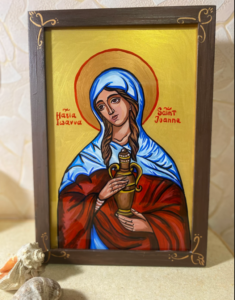 Last time I was tasked with finding Joanna the Myrrhbearer kitsch, I leaned into the myrrh, the thing with which Joanna is most identified. That was pretty easy: Myrrh-scented candles and bath bombs proliferate on the internet.
Last time I was tasked with finding Joanna the Myrrhbearer kitsch, I leaned into the myrrh, the thing with which Joanna is most identified. That was pretty easy: Myrrh-scented candles and bath bombs proliferate on the internet.
This year, I’m embracing some deep cuts.
First up, the obvious: A less kitschy, more lovely handwritten icon of Joanna, the better to contemplate her story.
The Gospel of Luke says Joanna, a member of Herod’s court, followed Jesus to the margins and provided for Jesus and his disciples from her own means. This T shirt echoes Joanna’s story with the message that Jesus empowered, respected and was funded by women, among other things.
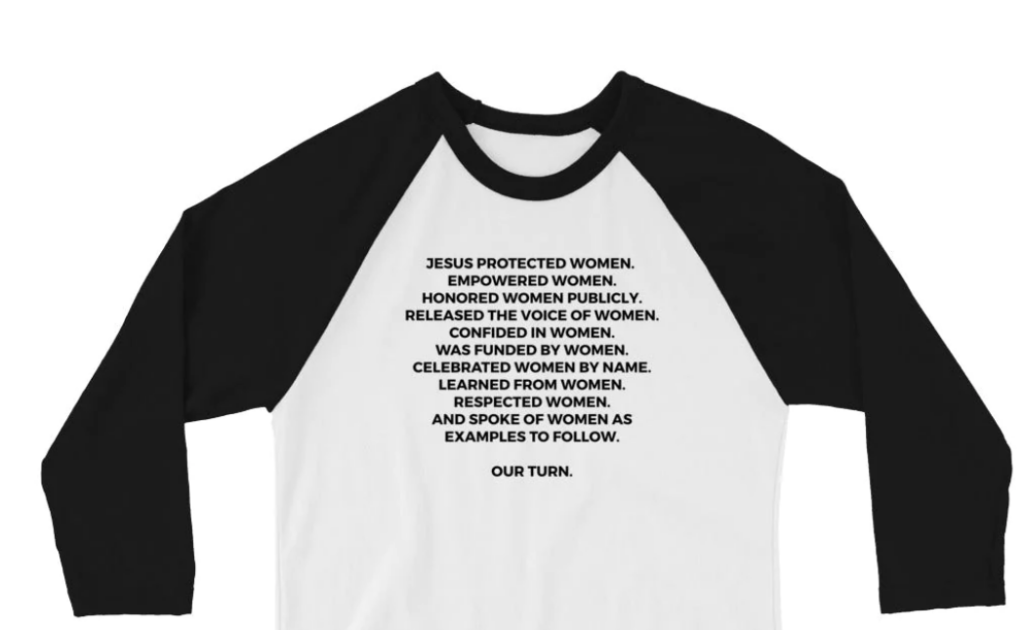 Luke also says Joanna was one of the women who followed Jesus to the tomb, bearing myrrh and other spices they had prepared to anoint his body for burial.
Luke also says Joanna was one of the women who followed Jesus to the tomb, bearing myrrh and other spices they had prepared to anoint his body for burial.
Hence the name.
She was not, as one friend thought when I mentioned I was writing about Joanna the Myrrhbearer, a “merbear” — that is, a mythical combination of fish and bear. Merbears are, however, a thing you can purchase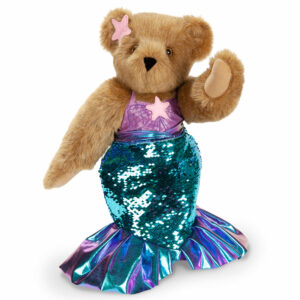 to lift your spirits at this point in the story, like this sparkly, snuggly mermaid bear made by the Vermont Teddy Bear Company, a sentence I never thought I would type during Lent Madness.
to lift your spirits at this point in the story, like this sparkly, snuggly mermaid bear made by the Vermont Teddy Bear Company, a sentence I never thought I would type during Lent Madness.
 Those who know the story know the women found the tomb empty that first Easter and were told by angels, “He is not here; he has risen!” The women returned to the apostles and shared the good news. Some consider them the first to preach the Gospel. But, Luke says, the apostles “did not believe the women, because their words seemed to them like nonsense.” If only they had had this AirPods case to encourage them, “Listen to women preach.”
Those who know the story know the women found the tomb empty that first Easter and were told by angels, “He is not here; he has risen!” The women returned to the apostles and shared the good news. Some consider them the first to preach the Gospel. But, Luke says, the apostles “did not believe the women, because their words seemed to them like nonsense.” If only they had had this AirPods case to encourage them, “Listen to women preach.”
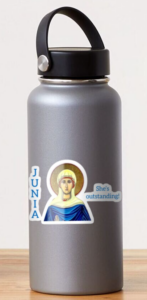 Some scholars believe Joanna may have been one of Luke’s sources for his Gospel and a leader in the early church, perhaps even the same person as Junia, who is described in the Book of Romans as “outstanding among the apostles.” So I have to sneak in a little Junia kitsch, just in case — like this vinyl sticker of Junia with the words, “She’s outstanding!”
Some scholars believe Joanna may have been one of Luke’s sources for his Gospel and a leader in the early church, perhaps even the same person as Junia, who is described in the Book of Romans as “outstanding among the apostles.” So I have to sneak in a little Junia kitsch, just in case — like this vinyl sticker of Junia with the words, “She’s outstanding!”
Blame that other Joanna — designer Joanna Gaines of “Fixer Upper” fame — if you will, but I’ve been making an effort to decorate my home for Lent and Easter this year, and one of my favorite finds is this wooden Easter “nativity” scene depicting Jesus, an angel and three women at the tomb. I’m going to go ahead and claim one of these little figurines as our saint and also maybe dust off some of Joanna Gaines’ brunch recipes for Easter morning. There are many ways to provide for others like Joanna.
Blandina
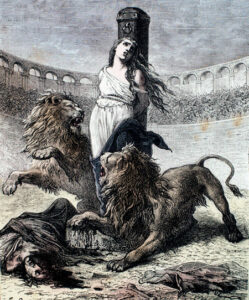 Blandina, a 15-year-old slave, was known for one phrase: “I am a Christian, and nothing bad is done among us.” Her story, her words, and the vivid images of her prolonged torture and martyrdom in 177 in modern day Lyon, France, survive and prove the lasting effects of those words.
Blandina, a 15-year-old slave, was known for one phrase: “I am a Christian, and nothing bad is done among us.” Her story, her words, and the vivid images of her prolonged torture and martyrdom in 177 in modern day Lyon, France, survive and prove the lasting effects of those words.
She is most often depicted surrounded by the vicious animals that tortured her. Illustrations, prayer cards, books, bracelets, stained glass windows, mugs all herald her tale.
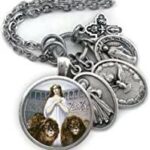 But perhaps the most awe-inspiring tribute is a song by Manuel Fúria:
But perhaps the most awe-inspiring tribute is a song by Manuel Fúria:
Irreducible to fragile Blandina,
I repeated these words
I raised these words
I'm a Christian, nothing bad is done between us
Blandina was taken to the arena
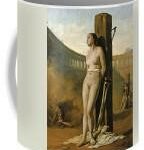 All open, raw to arena
All open, raw to arena
Blandina hanging on the wood
She prayed hanging on the tree
The lions that cast him
They didn't even touch you
I'm a Christian, nothing bad is done between us
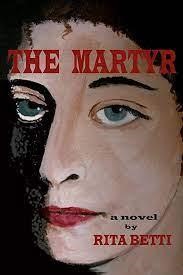 Blandina was taken again
Blandina was taken again
Thrown in the arena again
After the beasts in the arena again
After the flames in the arena again
They threw her to a bull
Thrown up by the beast
Was harvested, sacrificed
went to the other side
I'm a Christian, nothing bad is done between us.
72 comments on “Joanna the Myrrhbearer vs. Blandina”
Well done, bloggers! I voted for . . . the MERBEAR! because nothing says "Lent" like sparkly iridescent sequins and satin. The bloggers have set a blistering pace for this year's Kitsch round, but Emily had the advantage of the inside pole in that there are SO many PUNS for "myrrh"--obviating the need to have to spell it correctly! Don't like Kitsch round? Your Myrrhcury must be in retrograde!
As impressive as Joanna is, this time I voted for Blandina for her bravery and steadfast devotion to God and decency."I am a Christian, and nothing vile is done among us."
Cool! In Social Science, “kitsch” would serve as an “unobtrusive measure” of a construct. Here the amount of kitsch might suggest the staying power a Saint has had on the church. The degree of kitchiness, however, might be a quality measure. (It’s possible a Saint has had impact for the wrong reasons.) And how much a kitschy image costs on EBay, well, that might tell us relative value to a Jesus Image On A Piece of Toast… very rare.
Another tough choice. But I had to go with Joanna in honor of my friend and priest, Katrina (https://www.katrinasdream.org/katrinas-story/), whom I was reminded of by several of the above comments. Thank you, Lent Madness participants.
Two women, two who committed to Christ.
Joanna, amongst the first to realize the resurrection, helped lead others to “see” Christ and help spread the word… if not for her, and the other women who believed in Christ’s rising, Baldina may not have had a religion to pray to!
FYI - In Utica, NY there is a Blandina Street!
TY Mary! Not only NY but also Cincinnati - [https://www.cincinnatimagazine.com/features/sister-blandina-road-sainthood/ ] & [https://www.catholic.org/saints/saint.php?saint_id=339 ]
<3 and San Francisco - [https://www.cozymeal.com/hosts/1797/guide-blandina ]
<3 Though not a secure website, Springfield, Illinois [http://www.ilstatehouse.com/1894.htm ]
Praise Jesus!
The notion promoted by Emily McFarlan Miller, that Jewish women needed to be liberated by Jesus, is an absolute myth that has been debunked by academics who study the time period.
Rather, the Jewish women followers of Jesus had their own money to give, traveled, spoke in mixed company, took part in commerce, and much more, as a matter of course. In fact, archaeological remains of early synagogues show no separate women's sections, and historians of the evolution of synagogues suggest that separate women's sections developed many centuries later.
It's unfortunate that in order to promote Christianity, the anti-Jewish bias baked into a lot of Christian dogma has become commonplace, and is still promoted from many pulpits. What a shame to encounter it here as part of Lent Madness.
Please see Prof. Amy-Jill Levine's 2021 sermon at the Washington National Cathedral about Jesus in his Jewish context. (Prof. Levine is emerita prof of New Testament at Vanderbilt University, and has spoken and written widely in interfaith settings. She is an observant Jew and also has great respect for Christians and Christianity, having taught at the Vatican and in many other places.)
https://www.youtube.com/watch?v=8p0UxCc-Xp0&t=465s
I do not see the idea that "Jewish women needed to be liberated by Jesus" nor any anti-Jewish bias in what Emily McFarlan Miller has written about Joanna today. And after reading your comment, I went back and re-read her post twice. I also do not see it in her previous two posts this year. Ms. Miller has emphasized all along that Joanna was a woman of means and status, and that it was only in later centuries that her position as an authentic and important follower and supporter of Jesus was denigrated. Interestingly, that sounds to me much like what according to your sources happened with the development of separate women's sections in synagogues.
I don't see anti-Jewish bias in the text of the T-shirt, either. Nor in anything that Ms. Miller wrote in 2020, which I was inspired to revisit after reading your note.
I am however interested to learn about Jewish women's status in Jesus' time and plan to listen to Prof. Amy-Jill Levine's sermon. Thank you for that information and that link.
I love Joanna's Kitsch so she's got my vote today (especially the MerBear -- love it!)
I so often wondr if any of these very early Christian martyrs did exist?
As per my earlier comment, take a look at Elaine Pagels' description of Blandina & her fellow Christians in her "Gospel of Thomas."
OK, I give up; where could I get the Blandina mug?
Oh a very tough one!!!!!
Two truly outstanding write-ups!
I just need a little resurrection. in my life these days.
Thanks, Elizabeth and Joanna.
Sorry, Emily
My spellchecker has a mind of its own (luckily because I mislay mine from time to time.)
Once again not able to vote. No button to push again. I would have voted for Joanna if I had the chance.
I have the same problem on my iPhone. I have to vote from my computer. I would suggest trying to vote from a different browser or if you have access to a different device, try voting from it.
I have voted for both in previous rounds so this is tough, but I'm voting for Joanna the Myrrhbearer as she is one of the women known as the Myrrhbearing Women and an icon of these women which was written in honor of the consecration of our current Bishop, +Diana, and hangs in our Cathedral near the pulpit.
https://www.trinity-episcopal.org/post/new-icon-for-bishop-s-consecration